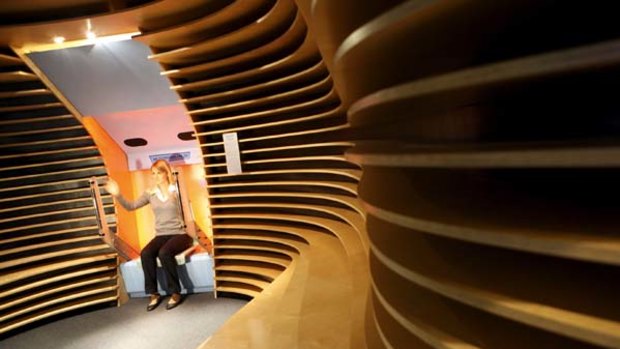
By arrangement ... testing the installations at Vienna's Haus der Musik.
With conductor's baton in hand, Michelle Fincke is inspired by Vienna's House of Music.
Sound is mysterious. It comes to us on the wind and gives shape and depth to our world. Its absence can be sinister or serene. As music, it divides generations, defines cultures and galvanises emotions; the sobs of Elgar's Cello Concerto are the essence of tragedy and sorrow.
How sound is made and our complex relationship with it is the intriguing subject of Vienna's Haus der Musik. In this well-mannered city fairly bursting its cobblestone seams with art collections and museums, a music museum is, you'd imagine, a cultural necessity.
Though housed in the home of Archduke Charles, third son of emperor Leopold II, a formidable military leader and thorn in Napoleon's side, the museum is invitingly low-key. Not far from the Lego-like roof and spires of St Stephen's Cathedral, the Haus der Musik has run education programs and innovative public events since it opened in 2000. The museum explores not just this city's relationship with music but, more fundamentally, the way we hear and how sound affects us.
There's an immediate, affectionate tribute to the city's most famous ensemble, the Vienna Philharmonic, regarded as one of the world's great orchestras. Its history dates to 1842 and has been led by a roll-call of renowned conductors, including Gustav Mahler, Arturo Toscanini, Wilhelm Furtwangler, Zubin Mehta and Leonard Bernstein.
Behind glass, the short, somewhat squat baton of Herbert von Karajan sits near the elegant, slender wand wielded by Richard Strauss, surrounded by letters and memorabilia from a golden age of music appreciation.
To loosen up visitors for the interactive exhibits, there's an installation inviting you to do as Chopin and Mozart apparently did for droll amusement: roll dice to determine the arrangement of musical phrases to create a cutesy piece for your next drawing-room recital.
Upstairs, the Haus der Musik delves into sound with interactive stations designed to show how our ears work, how sound travels and the emotional and intellectual impact of music.
Installations, all with English translations, are fun and involving but detailed, demanding time and concentration.
More visceral is the ''prenatal sensory rush'', a room designed to replicate the aural environment of a foetus in utero. Sounding more like a car manufacturer than a baby nurturer, the space whirrs and pulses with industry, challenging our belief in the peaceful interior life of the developing child with the notion of the baby factory working at full capacity.
Oddly, the Haus der Musik's least successful note should perhaps be its forte - a tribute to what Monty Python called the ''Decomposing Composers''. All the stars are here, from Mozart, Schubert and Chopin to Mahler and, of course, those waltzing Strausses, whose work is as Viennese as strudel and Sachertorte.
Beethoven, too, is remembered for making Vienna his home for his final 35 years and for being a fairly cantankerous tenant, shifting more than 60 times. Fate finally knocked on his door in 1827 and the Haus der Musik has the actual door behind which it is said that he died.
There are period instruments, letters and mementoes, glass cases full of dance cards and the coquettish accessories from the days of the grand Viennese waltz. While detailed, engaging and interesting, I think particularly with the quirky audio guide, the display struggles to make a particularly effective connection between the city, its people and its musical stars.
The section ends on a high note, however, with a snappy little installation that allows you to conduct a surprisingly responsive Vienna Philharmonic with an electronic baton.
Ascend the podium, follow the electronic score and assert your authority over the virtual musicians on the screen. It sounds daggy but channelling your inner Barenboim or Rattle is surprisingly uplifting.
My Eine Kleine Nachtmusik is wobbly out of the blocks and initially funereal, before entirely galloping away to sound like Chipmunks do Mozart. But control is restored, confidence grows, the baton sweeps become extravagant and the sound swells to an exhilarating finale.
The final area to explore is the Brain Opera, a sea of kooky, futuristic instruments devised at the Massachusetts Institute of Technology. Here, you can lose yourself in the fun of creating music simply by moving.
In a perfect museum for teenagers, you can mix your own CD, blending rhythms and sounds that include a dentist's drill, laughter, an alarm clock and the crackly chatter on board Apollo 11. As a souvenir of this musical city, it sure beats a snow dome.
It wouldn't be Vienna without dignified refreshments, so there's a cafe and a lively gift shop stocked with busts of Mozart and Beethoven, ready to grace your piano.
Inspired, I slink out with a baton - I wanted Mahler's but settled for a Vivaldi reproduction for some Four Seasons work at home. After a week in Vienna, anything but the Blue Danube.
Haus der Musik (House of Music), Seilerstatte 30, 1010 Vienna. Open daily 10am-10pm, adults €10 ($14). children €5.50, see hdm.at.
Emirates has a fare for about $1820 flying to Dubai (about 14hr), then Vienna (6hr). Austrian Airlines has a fare for about $2120 flying Thai to Bangkok (about 9hr) and then Austria to Vienna (11hr 25min). Fares are low-season return from Melbourne and Sydney, including tax.
Sign up for the Traveller Deals newsletter
Get exclusive travel deals delivered straight to your inbox. Sign up now.